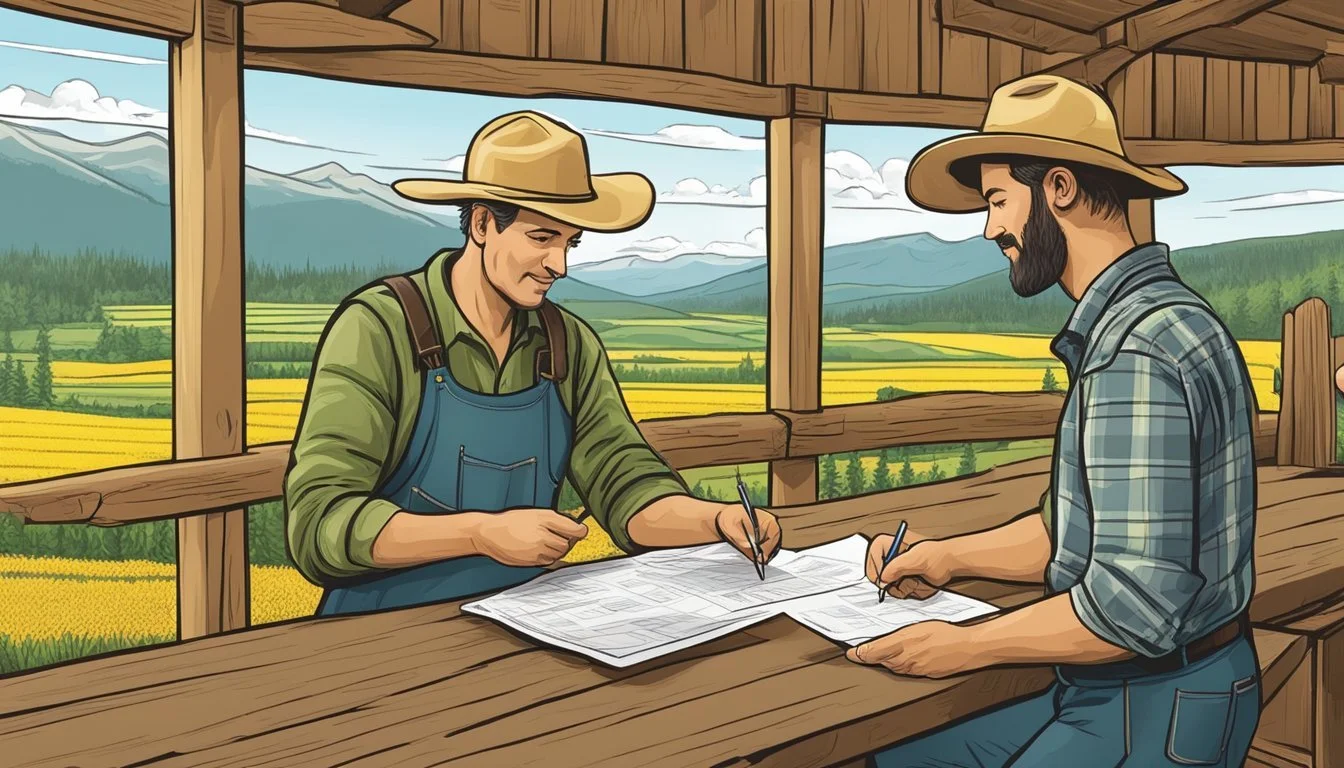Oregon Farm Land for Lease
Opportunities and Options for Prospective Tenants
This Article is Part of Our Guide on Navigating Agricultural Leases Across the US
Oregon's diverse agricultural industry offers a variety of farm land lease opportunities, catering to both seasoned and emerging farmers. The state's rich soil and favorable climate conditions make it an attractive location for farming a wide range of crops. The concept of leasing farm land appeals to individuals who are looking to enter the agricultural sector without the immediate financial burden of purchasing property.
In recent years, the availability of farm land for lease in Oregon has expanded, providing access to land for those who may not have the capital to invest in land ownership. Leasing also offers flexibility and can act as a stepping stone for farmers to establish their operations before committing to a purchase. As such, leasing farm land has become a strategic move for many in Oregon’s farming community.
Potential lessees can find a variety of land options, from small plots suitable for boutique organic operations to expansive acreage for traditional crop production. The range in rental costs reflects the diversity of the land itself, with factors like location, land quality, and existing infrastructure influencing the lease price. Organizations and online platforms provide listings and connections to help facilitate successful land leases tailored to individual agricultural objectives.
Understanding Oregon Farm Land Leasing
When engaging with farm land leasing in Oregon, it is essential to grasp the logistics of the lease itself, recognize the various types of land available, and differentiate between commercial and agricultural leasing. Well-informed tenants and landholders can help ensure the vitality of Oregon's agricultural heritage.
Lease Fundamentals
Leasing entails a legal agreement where landholders offer their land for use by another party. In Oregon, the average lease rate for farm land has increased over time, reflecting changes in the market and agriculture sector. Farmland rental rates can vary significantly based on factors such as acreage, land quality, and local market conditions. For instance, the number of acres for lease and the specific land type can influence the price. For small farms, particularly those involved in biodynamic, season extension, or pasture-based systems, carefully structured leases are vital to their operation.
Lease Factor Description Average Lease Rate As of recent data, rental rates may hover around $179 per acre. Term Length Lease agreements may differ in duration, commonly ranging from a single season to multiple years. Lease Type Different leases may apply to livestock versus crop production, potentially including special arrangements like cattle, goats, sheep, and poultry.
Types of Farm Land for Lease
The land for lease can be categorized based on its primary use, and in Oregon, this includes crop land, pasture land, and specialty areas designed for particular types of farming. Crop land supports the growth of grains, fruits, and vegetables, while pasture is commonly leased for grazing animals like cattle and sheep. Some land might also be equipped for specific agriculture practices or features like tractors and equipment for season extension, which allows for prolonging the growing season.
Commercial vs. Agricultural Leasing
The distinction between commercial and agricultural leasing is an important factor in Oregon's leasing landscape. Commercial leases generally refer to land used for commercial activities which might not be directly related to farming. Conversely, agricultural leases are specifically tailored to farming and livestock. Farm leases in Oregon prioritize the long-term sustainability and productivity of the land, ensuring that farming practices like biodynamic or organic methods can be effectively implemented. While financial gain is a consideration in both types, maintaining the agricultural value of the property is more emphasized in agricultural leases.
Lease Type Focus Commercial Non-agricultural business activities Agricultural Farming and livestock operations
In Oregon, while a portion of farmland is leased out, the overarching goal is to support and grow the next generation of family farmers, ensuring that land leases play a role in preserving agricultural heritage and contributing to food security.
Financial Aspects of Leasing
When entering into a leasing agreement for agricultural land in Oregon, financial considerations play a pivotal role. The lease or rent rates, often determined on a per acre basis, are influenced by several factors including land type and intended use.
Average Listing Price and Lease Rates
Listing Price: The cost to lease agricultural land in Oregon varies based on numerous conditions including land quality, location, and available infrastructure. Historically, the average farmland rental rates in Oregon have shown an upward trend, reflecting the changing dynamics of the agricultural industry.
2019 Figures: An average of $179 per acre with an implied capitalization rate of 5.4%.
2022 Differentials: For irrigated cropland, expect to pay a premium. Statewide, this could be about $160/acre more when compared to non-irrigated cropland.
Land Type Average Lease Rate Non-irrigated Cropland $179/acre Irrigated Cropland $339/acre (approx.)
Average Property Size and Lease Cost
Property Size: The size of the property directly influences the total lease cost. Larger properties typically command higher total lease fees, albeit potentially lower per acre rates due to economies of scale.
State Data: About 30% of all farmland in Oregon is leased.
Acreage for Lease: The average property size up for lease and the corresponding costs are critically important for budgeting and operational planning.
Acreage (in acres) Average Lease Cost 100 $17,900 (based on $179/acre) 500 $89,500 (based on $179/acre)
These figures serve as benchmarks for prospective lessees to estimate leasing expenses and to compare against potential revenue from the land's agricultural use.
Locating Farm Land for Lease in Oregon
In Oregon, prospective lessees have various options when it comes to finding farm land for lease, including diverse acreage sizes and regional characteristics, particularly in the Willamette Valley area and surrounding counties.
Willamette Valley and Surrounding Counties
The Willamette Valley, recognized for its fertile soil and favorable growing conditions, is a prime location for leasing agricultural land. Surrounding counties offer a range of properties, often providing ample acreage for diverse farming needs. For instance, listings may vary from smaller plots suitable for boutique farming ventures to extensive hundreds of acres that can support large-scale agricultural operations.
Typical Acreage for Lease:
Small-scale plots: < 50 acres
Medium-scale farms: 50-200 acres
Large agricultural operations: 200+ acres
Listing Age and Land Availability
The average listing age for land for rent in Oregon varies, with some properties becoming available seasonally and others year-round. Current property listings do not always provide precise information on listing age but do offer key details on land availability and lease terms. Lessees seeking current information on available land for lease must stay attentive to updates from local land marketplaces and resources like Oregon Farm Link, which facilitates connections between landholders and seekers.
Land Availability Indicators:
Seasonal Listings: May present opportunities for short-term leases.
Year-Round Listings: Indicative of a stable lease market, potentially offering longer terms.
By understanding both the geographic advantages of regions like the Willamette Valley and the dynamics of listing availability, interested parties are better equipped to locate and secure suitable farm land for lease in Oregon.
Legal and Contractual Considerations
When engaging in the leasing of farmland in Oregon, it's essential to understand the legal agreements involved and ensure compliance with state regulations. Ensuring that these legalities are properly addressed preserves the interests of both landowners and lessees.
Understanding Lease Agreements
An agricultural lease is a binding contract that outlines the terms under which the lessee is permitted to use the landowner's property for farming activities. In Oregon, while verbal agreements are possible, the best practice is to create a written contract that details all terms and conditions to prevent disputes.
Key Elements of a Lease Contract:
Duration: Specifies the length of the lease agreement.
Rent: Defines payment terms, whether fixed or as a revenue share.
Responsibilities: Clearly outlines maintenance and repairs.
Termination: Describes the process and conditions for ending the lease.
State Regulations and Compliance
Oregon has specific real estate regulations that govern agricultural leasing. Lessees and landowners must be aware of and comply with these laws to ensure that their agreements are enforceable and legally sound.
Legal Requirements: Every lease must adhere to Oregon's real estate laws, including zoning, environmental regulations, and land use restrictions.
Documentation: Proper and accurate record-keeping is crucial for meeting state compliance standards.
Preparation and Management
When leasing farm land in Oregon, it is crucial to carefully consider the infrastructure and equipment necessary for efficient operation, as well as the tactics for managing livestock and crops for maximum productivity.
Farm Infrastructure and Equipment
Adequate farm infrastructure is essential for the success of any agricultural venture. In Oregon, lessees should evaluate the current state of:
Fences and Storage: Ensure that fences are secure for livestock and that storage facilities are adequate for equipment and harvested crops.
Access to Water: Verify availability and rights for irrigation, a critical component for both crop and livestock sustainability.
For equipment, lessees may need to invest in or lease:
Tractors: Essential for plowing, planting, and other field work; consider local dealerships for lease options.
Season Extension Tools: Greenhouses or hoop houses can be useful for extending the growing season in Oregon's varied climate.
Biodynamic Farming Tools: If adopting biodynamic practices, specific preparations and equipment like compost starters and planting calendars are required.
Livestock and Crop Management
Livestock management on leased land involves:
Pasture Rotation: Rotate cattle, goats, sheep, and poultry to maintain soil health and control parasites.
Health Checks: Regular veterinary care to keep livestock healthy and productive.
Crop management for lessees should prioritize:
Soil Fertility: Use crop rotation and cover cropping to enhance soil without relying solely on external inputs.
Pest and Weed Control: Implement integrated pest management strategies that benefit small farms and reduce dependence on chemicals.
Each aspect of preparation and management serves to ensure that lessees can run an effective agricultural operation on Oregon's diverse farmland.
Creating a Safe and Welcoming Farm Environment
Creating a safe and welcoming environment on an Oregon farm involves several key practices. Farm operators should be committed to fostering a community where respect is paramount and diversity is embraced. Here are some approaches they might take:
Respectful Communication: Dialogue on the farm should be grounded in respect, ensuring all individuals feel valued and understood.
Community Engagement: Inclusive events and programs that bring farm workers and local residents together can reinforce community bonds.
Workplace Safety: Farms must adhere to safety protocols to protect everyone on the premises. This includes proper training and equipment.
Transparent Operations: Sharing farm practices and goals with the community promotes trust and collaboration.
Tenant Farmers' Responsibilities:
Promote Diversity: Tenant farmers might commit to practices that honor different backgrounds, expressing openness to all community members.
Educate and Train: Providing education about safe farming practices ensures that all team members are well-informed.
Communication Channels: Establishing clear lines of communication for concerns or suggestions can help maintain a positive environment.
By prioritizing safety, respect, and community engagement, Oregon farmers create a thriving atmosphere that benefits both the farm and the surrounding areas. The intention is to cultivate not just crops, but also a sense of belonging and mutual support.






